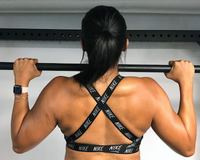Improve deltoid training and build a more impressive body by comparing two of the most effective shoulder exercises: the dumbbell shoulder press and the barbell press.
When showing off a big, wide physique, big, muscular delts can set you apart. Width is an instant indicator of power, strength and an incredible physique. The goal is to reap the rewards of all the sweat, sacrifice and hard work you tirelessly do in the gym, so why not get the most out of it?
Shoulder presses, lateral raises, upright rows, and shoulder shrugs are well-known tools essential for anyone dreaming of deltoids becoming a reality. But how do you choose the best way to build muscle for your deltoid? The shoulder press is the granddaddy of all deltoid presses, with various variants and techniques to quickly gain strength and support other lifts. The two most common are the barbell and dumbbell shoulder presses. Each has its unique advantages, but let's break down these two basic moves into their respective parts and see which move is better.
The barbell shoulder press is on the same list as the bench press, squats, and rowing and is only an exercise for those looking to gain their deltoid muscle. As a multi-joint exercise, the barbell shoulder press allows you to use more weight for long-term overload to gain more strength.
Barbell Shoulder Press: How, pros, cros
The barbell shoulder press is on the same list as the bench press, squats, and rowing and is only an exercise for those looking to gain their deltoid muscle. As a multi-joint exercise, the barbell shoulder press allows you to use more weight for long-term overload to gain more power.


How:
- Sit on a bench press with a backrest in a squat rack. Hold the bar in a down-grip position (palms forward). Adjust the bar height just above your head.
- Hold the bar with the correct grip and lift it over your head, locking your arms into position. Stay at shoulder level, slightly in front of your head. This is your starting position.
- Slowly lower the bar to the shoulders while breathing in.
- Lift the bar back to the starting position while exhaling.
- Repeat this action up to the recommended number of times.
- This exercise can also be performed in a standing position.
Pros: The multi-joint nature of the barbell shoulder press, unlike other movements, build muscle and strength. Activating the front and medial parts of the deltoid complex, the barbell shoulder press is also beneficial for building muscle and strength in other areas, such as the traps, triceps, and upper chest. Simple, basic, and relevant to practical use, it's useful.
Cros: Since overall muscle is the main advantage of the barbell version, it cannot distribute the load to the rear delts, potentially causing injury if not exercised properly. The conceit often lifts its ugly head, and the shoulder press becomes a shoulder burner rather than a builder. Short distances and a tendency to use too much weight are two red flags regarding injuries. Impacts, chronic soreness, and upper and lower back strains are common when you take them to extremes.
Dumbbell Shoulder Press: How, pros, cros
The dumbbell shoulder press is another tedious exercise you see in the gym. Often preferred over the barbell version due to equipment availability, the dumbbell press is a highly effective move for full muscle development.

How:
- Sit on a bench with a backrest, hold a dumbbell in each hand and place it on your lap, palms facing each other. Then lift the dumbbells on both sides with your thighs and put them on your shoulders. Extend your upper arms so that your palms are forward and your elbows are facing. Lean back against the backrest. This is where the action starts.
- Extend your arms and lift the dumbbells overhead while exhaling. Squeeze the shoulders by bringing the dumbbells toward the middle at the top, and pause for a while.
- Slowly lower the dumbbells back to the starting position while breathing in. Maintain power control over the dumbbells as you descend.
- The above is a complete action, repeat the action the recommended number of times.
Variation: If your back is fine, you can do this while standing or sitting on a stool without a backrest.
Pros: Since you're using two dumbbells that move independently, this version of the press forces you to use more of your supporting muscles. Also, because the elbows point to the sides (unlike the barbell version, which means slightly forward), you get more muscle fibers from the medial and posterior delts. Finally, since you'll be using a more independent range of motion, you won't have to use as much weight, reducing your risk of injury.
Cons: If you have balance, range of motion, or ego issues, there are better choices than the dumbbell shoulder press. If you're doing half-reps with a lot of weight, you're asking for trouble. Some people also need help getting the weight up to the starting position. Finally, maintain an upright upper body position on a bench or seat. I see too many people sinking into the seat, the movement will change from a shoulder press to an incline bench press.
Final choice
Of course, the choice ultimately comes down to your personal preference, comfort level, and injury propensity. Both have practical, real-world applications, the barbell version will put more load on your anterior deltoid with heavier loads, while the dumbbell version will help refine the entire deltoid area that requires more control and Skill.
You can easily incorporate these two movements into your current training program, rotating the barbell press for heavier strength days and dumbbell presses for lighter, higher rep build days. The choice is yours, but both will serve you well.
IFAST Best Deals
Are you short of Olympic bars or dumbbells?
IFAST provides you with many options!
💥 There is a big discount(40% off) for you, don't miss it; buy it now!
Click and shop 👉 here












